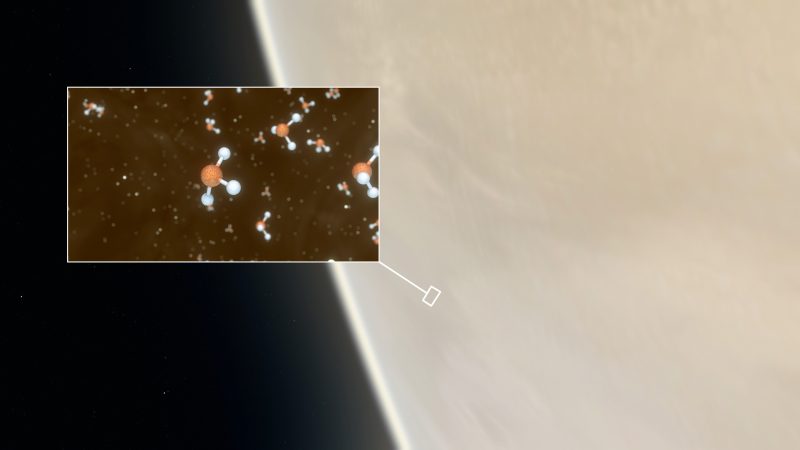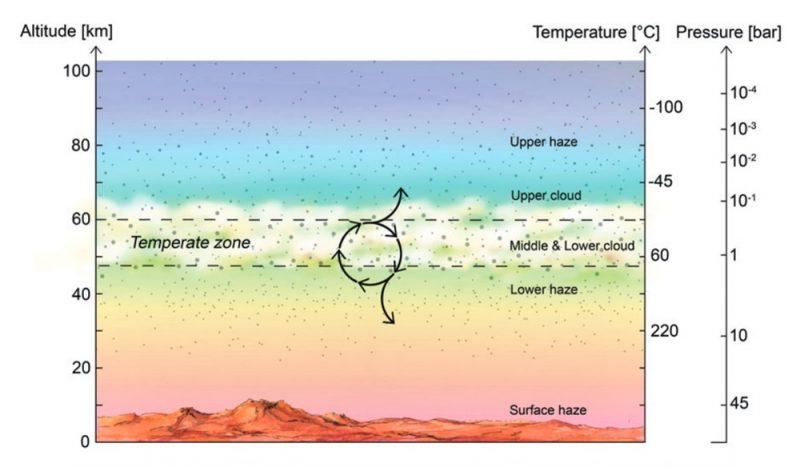
In late 2020, scientists studying the atmosphere of Venus announced the surprising – and controversial – discovery of phosphine, a chemical that, on Earth, is produced primarily by living organisms. Jane Greaves at Cardiff University in Wales and her colleagues asked at the time: could the phosphine be a sign of microorganisms inhabiting Venus’ atmosphere? Maybe, other scientists said, but phosphine itself wouldn’t be proof of life, and subsequent studies questioned whether the phosphine was ever there at all. Then – in March 2021 – a study from Rakesh Mogul of Cal Poly Pomona supported the original finding of phosphine and went further. It suggested that other “biologically relevant chemicals” in Venus’ atmosphere appear to be in a state of disequilibrium: another hallmark of life.
The new study focused on the re-analysis of data from the old Pioneer Venus mission, which sent four probes into Venus’ atmosphere in 1978, collecting data as they plunged toward the surface. This was the Pioneer Venus Multiprobe part of the mission, with three small probes and one larger one. The scientists analyzed data from the largest probe. The tantalizing peer-reviewed results were published in Geophysical Research Letters on March 10, 2021.

From the paper:
We re-examined archived data obtained by the Pioneer Venus Large Probe Neutral Mass Spectrometer. Our results reveal the presence of several minor chemical species in Venus’ clouds including phosphine, hydrogen sulfide, nitrous acid (nitrite), nitric acid (nitrate), hydrogen cyanide, and possibly ammonia.
The presence of these chemicals suggest that Venus’ clouds are not at equilibrium; thereby, illuminating the potential for [possibly life-related] chemistries yet to be discovered.
Mogul and his team found that the original analysis back in 1978 focused only on the most common chemicals that were expected to be found in Venus’ atmosphere. He told space journalist Nancy Atkinson in a March 25 article for The Planetary Society:
The focus on the minor and trace [chemical] species was minimal. That’s what we realized after looking at the archival data and the associated publications. We immediately found signals in data that other publications hadn’t discussed or mentioned. That was all we needed for motivation to keep going.
As well as phosphine, the new analysis suggested the existence of additional chemicals including hydrogen sulfide, nitrous acid, nitric acid, hydrogen cyanide, carbon monoxide, ethane, and potentially ammonia and chlorous acid.
According to Mogul and his team, these chemicals could be evidence for redox disequilibria, processes suggestive of life. For example, on Earth, microbes take advantage of the redox disequilibrium found in natural environments like water to derive energy. Could something similar be happening in the atmosphere of Venus? Are parts of the atmosphere, at least, a potential habitable zone for microorganisms?


The data for this study come from the Large Probe Neutral Mass Spectrometer (LNMS), which was on the largest of the four probes that descended to Venus’ surface in 1978. The composition of the atmosphere was measured several times during descent. LNMS targeted gas molecules in the atmosphere that have a neutral charge. Phosphine would be one of those gases.
The Pioneer Venus data are important, especially since they were obtained in situ, in the atmosphere itself, instead of remotely by Earth-based telescopes, as the other data last year had been.
The disequilibrium in Earth’s atmosphere is due to life, but whether the same is true for Venus is still unknown. This latest study supports that it could be, but more data are still needed, most likely from a return mission, to know for sure. Astronomers also say that this kind of disequilibrium could be used to search for evidence of life on exoplanets. Wouldn’t it be fascinating if that first evidence actually came from someplace much closer to home? From the linked paper in Science Advances (2018):
Chemical disequilibrium in planetary atmospheres has been proposed as a generalized method for detecting life on exoplanets through remote spectroscopy. Among solar system planets with substantial atmospheres, the modern Earth has the largest thermodynamic chemical disequilibrium due to the presence of life.

I asked Greaves on Twitter what she thought about the new analysis:
We're excited! … our team is a bit quiet at the moment because of individual circumstances, but congratulations to the Pioneer Venus team on their fabulous sleuthing!
— j greaves (@jgreaves6) March 31, 2021
Something else that isn’t known yet is whether there could be any correlation between the chemicals found and the unusual “unknown absorber” dark patches in Venus’ atmosphere. Some scientists had previously hypothesized that they could actually be microbes, since the size and absorption characteristics of the particles in the patches were found to be similar to some earthly bacteria. I asked Mogul and he replied:
I like that thought. We’re still sorting it out tho. Some of the chemicals we found do absorb between 350-400 nm. ?
— Rakesh Mogul (@RakeshMogul) March 26, 2021
Today, the surface of Venus is horrendously uninhabitable, with temperatures of 840 degrees F (450 degrees C) – hot enough to melt lead – and crushing atmospheric pressure. But the middle layers of the atmosphere are temperate and Earth-like in temperature and pressure, although the clouds do contain abundant sulphuric acid. But there has been growing evidence that the planet used to be much more Earth-like earlier in its history, with rain, lakes and oceans. Less than a billion years ago however, something happened to cause a catastrophic greenhouse effect, where Venus transformed into the hellish world we see today.
Could there have been microscopic life of some kind, which then sought refuge in the clouds, away from the burning surface? Perhaps.
It will be very interesting to see what other follow-up studies say about this newest chapter in the phosphine on Venus enigma, and the possible disequilibrium. As Mogul said:
There are always mysteries to be solved and I think what we just showed that sometimes old data can reveal new stories. This is all a process, and moving forward is what science is all about.

Bottom line: A new analysis of data from the 1978 Pioneer Venus mission finds evidence not only for phosphine, but also possible chemical disequilibrium in Venus’ atmosphere, an additional possible sign of biological activity.
Source: Venus’ Mass Spectra Show Signs of Disequilibria in the Middle Clouds











